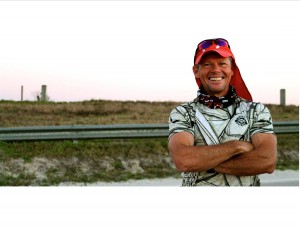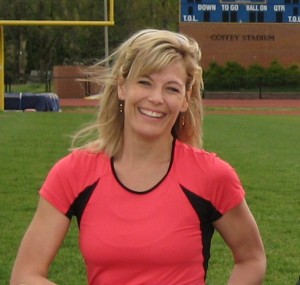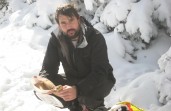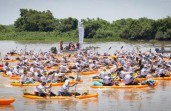Grant Maughan
 Grant Maughan, age 50, has become well-known in the endurance and adventure racing circuits as of late, with a couple of second-place finishes at Badwater and top finishes in other top-tier endurance foot races like the Brazil 135. A newcomer to endurance racing, he’s had enormous success over the past few years and has built an impressive resume in a short period of time – and has bigger and better plans ahead.
Grant Maughan, age 50, has become well-known in the endurance and adventure racing circuits as of late, with a couple of second-place finishes at Badwater and top finishes in other top-tier endurance foot races like the Brazil 135. A newcomer to endurance racing, he’s had enormous success over the past few years and has built an impressive resume in a short period of time – and has bigger and better plans ahead.
Grant Maughan was chilling out in the home of Jay Batchen and Lisa Smith-Batchen when I caught up to him between training sessions. Maughan, a native of New Castle, Australia, decided to take a sabbatical from years at sea captaining private ships and yachts to train and compete in hard-core adventure and endurance-distance foot races. He moved into the Batchen residence to take refuge on land, as well as to take instruction directly from Smith-Batchen. As a long-term guest (he’s been there over six months), he performs a list of household chores – such as cooking dinner at least once a week as well as walking the dogs and other general chores – that help maintain the Batchen home.
Maughan is training for the Arrowhead 135, a difficult winter self-sustaining adventure race which is run from Frostbite Falls on the Canadian border across the Northern Region of Minnesota, USA. The race has gained in popularity over 11 years, boasting athletes from USA, Canada, India, Finland, Argentina, Brazil, Australia, and the UK.
 “The race starts Monday, January 26, and you have 120 hours to complete it,” Maughan told me. He chose the race based on its difficulty, and turned to Smith-Batchen (who he met 18 months ago) to provide a training schedule. At first, they worked long-distance while he was at sea or stationed in Florida. She sent a two-week training schedule for Maughan to follow.
“The race starts Monday, January 26, and you have 120 hours to complete it,” Maughan told me. He chose the race based on its difficulty, and turned to Smith-Batchen (who he met 18 months ago) to provide a training schedule. At first, they worked long-distance while he was at sea or stationed in Florida. She sent a two-week training schedule for Maughan to follow.
“I’m a pretty good student. I followed it to a T. At the end of that, I sent in what I’d done. She asked me about my diet to make sure I was on track,” Maughan said.
When it came to training for Arrowhead, Smith-Batchen met with Maughan to discuss how to train for the challenging conditions.
“She sat down with me to talk about how things would be different running in the snow,” Maughan explained. “This race is a lot about gear; and since temperatures can plummet to -40 Fahrenheit, you need to be cognizant about the temperature extremes.”
Athletes are required to pull a sled with their gear for the duration of the 130 miles. Competitors run along a groomed snowmobile trail and must finish the race with all the gear they bring in – and there is a lot of it. Given the temperature extremes, athletes need to pack wet-weather gear, a stove, a sleeping bag, snow shoes, and other cold-weather gear.
“You don’t want to freeze to death,” Maughan added. “The checkpoints are only every 40 miles, so you are really out there on your own.”
From Sea Captain to Endurance Racer
Maughan has been a professional sea captain for 29 years, captaining on different boats, ships and yachts. When he turned 50, he wanted to take some time off and stay on land; his last job had kept him onboard for 7 years – a long stint for a captain. When I asked him about how he trained, he said, “[Training] Takes up so much time, and when I got into endurance sports and running ultras I had to get really creative.”
Maughan had always been athletic, but he didn’t become a runner until his forties. When he was 47, he ran the West Palm Beach Florida Marathon in December 2011 (his first marathon) and qualified for Boston. At the time, the boat he was captaining just so happened to docked for a while; the owner, who liked to sail around the world, wasn’t using it as often.
After completing the marathon, Maughan just skipped up the endurance, running a 50k, then a 100k, and then completing the Keys 100-miler five months later.
After that, he wanted to try another trail 100-miler and chose the Burning River in Ohio, which took place in August. In 2012, Maughan completed his first triathlon and competed in HURT in Hawaii. In 2013, he chose to run the Boston Marathon – the year of the bombing.
“It was bittersweet and a great experience; I gained another PR at that race,” Maughan said.
In 2014, Maughan did 15 ultras. By the time he settled in on running events in Vancouver, where he was living at the time with his wife of 19 years, the marriage had fallen apart. Maughan kept to himself and kept running, and focused on the Fat Dog 120-miler as one of his signature races.
“It’s one of the most beautiful races I’ve ever done,” he said. “Thirty people started it, and only 10 finished. The race has gained in popularity; there are already 120 entrants signed up for this year [2015].”
Focus on Badwater
Early on, after Maughan ran his first 100-miler, he had in the back of his mind that he would compete at Badwater. In 2013, Maughan qualified and turned to fellow endurance racer and owner of Sky Dive Ultras, Eric Friedman, to be his pacer.
“I met Eric at the Keys 100-miler and we kept in touch. When I qualified for Badwater, he was one of the first guys I contacted. He’s just a solid guy,” Maughan said.
Maughan decided to enlist the help of a coach for the race, preferring a female coach. “I shopped around, found Lisa, and within one minute we clicked,” he said.
Friedman crewed Maughan in 2013 for Badwater. He got second place in both 2013 and 2014. He will go back again in 2015 to try for another win. He is, I observed, one of the first people I know to run Badwater three times on three different courses. In 2013, Maughan ran the original Badwater course through Death Valley; but in 2014, the National Park Service prohibited the race from being run on the original course, and competitors ran on an altered course which didn’t include Death Valley. In 2015, competitors will be allowed to start in Death Valley, but in the dark with an 11 PM start instead of the original 5 AM start.
Mental Toughness, Training and Diet
Maughan’s favorite distance is 100 miles or longer. “I’m a pretty little guy and I prefer a longer race and I can keep going. I do want to try some 100k trail races just to mix things up, but you’ll see me mainly doing the 100-miler plus,” he said.
I asked him what makes him tough; Maughan believes his work experience has a lot to do with it.
“I think I’ve learned to be tough by being at sea,” Maughan reflected. “I’ve done hard manual labor in difficult situations. I’ve had experience with staying up all night. I’ve stayed awake for days on end onboard a sea trawler.”
But Maughan is mentally tough for another reason: In 2004, he was in a boating accident and punctured his left eye, leaving him blind on that side. He has to be careful now, especially on the trails, and uses a very powerful headlamp for night running.
In addition to the toughness he built at sea, Maughan is driven – and that is something you are born with.
“If you do these races, everyone asks, ‘How do you get through it?’ It’s very difficult to learn, if not impossible. My thing is, I hate not getting things done; and I have such a desire to finish, I just push myself through it. And remember, I hurt just as much as everyone else. The mental fortitude comes from stubbornness!”
To compliment his training, Maughan allows 3-4 days off for recovery. During those days, he may swim or bike; after those days, he incorporates some easy short runs. About a week later, he will ramp up. Maughan explained that he is interested in the least amount of miles for the maximum benefit.
And that training philosophy has earned him some course records and first-place finishes.
When I asked Maughan what comes after Arrowhead, his answer was clear.
“I want to get back to Florida to run in the heat.”
About the Arrowhead 135
http://www.arrowheadultra.com/
The Arrowhead 135 is a human-powered ultra marathon taking place during the coldest part of winter in northern Minnesota. The average finish rate is less than 50%; the finish rate for new racers is much lower. In 2014, finish rate was only 35%.
The race is 135 miles long and takes place in the deep winter on rugged, scenic Arrowhead State Snowmobile Trail, from Frostbite I-Falls to Tower, Minn., Fortune Bay Casino. Athletes pick their mode of transport at the start: bicycle, ski or foot. The race is in its 11th year, beginning with 10 entrants in 2005 and growing to ~150 starters for 2014, featuring some of the best winter ultra-athletes in the world.
 Download the Jan/Feb 2015 Issue at: http://www.magzter.com/US/Endurance-Racing-Magazine/Endurance-Racing-Magazine/Business/114385
Download the Jan/Feb 2015 Issue at: http://www.magzter.com/US/Endurance-Racing-Magazine/Endurance-Racing-Magazine/Business/114385















